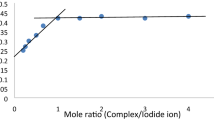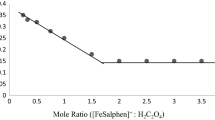Summary
At elevated temperatures (⩾ 70 °C) the title complex aquates significantly in aqueous acid media, releasing one thiocyanate in the first step, which exhibits no acid dependence. For this spontaneous aquation, the rate constant (kspont.) at 25 °C, ΔH≠ and ΔS≠ are 1.2×10−8s−1, 132 kJ mol−1 and 59 JK−1mol−1, respectively. This first step is followed by a slower second step in which, the second thiocyanate is released as the Co(dmgH)2 moiety is cleaved. The rate of release of thiocyanate is enhanced considerably by addition of Hg2+ and the complex changes smoothly into the corresponding di(aqua) product, [Co(dmgH)2(OH2)2 +, without any complicating side reactions. Both the steps of the process are linearly dependent on [Hg2+]. For the catalysed reaction, the second-order rate constant at 25 °C, ΔH≠ and ΔS≠ for the first and second steps are 2.85 M−1s−1, 89 kJ mol−1, 60 JK−1mol−1; and 1.48 M−1s−1, 63 kJ mol−1, −30 JK−1mol−1, respectively. The observed linearity of the kobs vs [Hg2+] plots over a wide range of [Hg2+] concentration suggests a direct electrophilic (SE2) attack of the Hg2+ on the leaving thiocyanate ligand of the substrate complex; there is CoIII-NCS bond fission without the involvement of any long-lived binuclear intermediate of the type CoIII-NCS-HgII.
Similar content being viewed by others
References
See for example, J. P. Birk,Inorg. Chem., 10, 66 (1971).
J. H. Worrell,Inorg. Chem., 14, 1699 (1975).
See for example, S. F. Chan and S. L. Tan,J. Inorg. Nucl. Chem., 38, 345, 2161 (1976).
L. C. Falk and R. G. Linck,Inorg. Chem. 10, 215 (1971).
A. Adegite, M. Orhanovic and N. Sutin,Inorg. Chim. Acta, 15, 185 (1975).
M. M. Jones and H. R. Clark,J. Inorg. Nucl. Chem., 33, 413 (1971).
H. S. Lim and F. C. Anson,Inorg. Chem., 10, 103 (1971).
V. R. Vijayraghaban, N. Thillaichidambaran, A. Raghaban and M. Santappa,J. Indian Chem. Soc., 55, 532 (1978).
A. V. Ablov and M. Fillipov,Zh. neorg. khim, 4, 2204 (1959).
Z. Finta, Cs. Varhelyi and J. Zsako,J. Inorg. Nucl. Chem., 32, 3013 (1970).
Preliminary observations in our laboratory have shown that in presence of Hg2+ (0.02 M), [Co(dmgH)2Cl2]− (0.001 M) transforms to [Co(dmgH)2(OH2)2]+ in two steps. The first step is almost instantaneous, while the other takes about 50 seconds for completion at room temperature. Even the spontaneous aquation of [Co(dmgH)2Cl2]− is complete within a few hours at room temperature,cf., D. Banerjea and J. Roy,J. Indian Chem. Soc., 53, 221 (1976); V. I. Belevantsev, E. I. Evdokimova and B. Peshchevitskii,Izv. Sib. Otd. Akad, Nauk SSSR, Ser Khim, Nauk, 38, 1, (1978),C. A., 88, 177765w (1978).
R. N. Banerjee and D. Banerjea,Indian J. Chem., 17A, 250 (1979).
See for example, A. B. Venediktov and A. V. Balyaev,Russ. J. Inorg. Chem., 17, 1158 (1972).
D. Sen and P. Ray,J. Indian Chem. Soc., 11, 899 (1934). These authors formulated this complex as the non-ionic [Co(dmgH2)(dmgH)Cl2], which however, is now known to be actually H[Co(dmgH)2Cl2] (cf. ref. 11).
A. I. Vogel,Quantitative Inorganic Analysis, 3rd Edit. Longmans, London, p. 488 (1969).
Author information
Authors and Affiliations
Rights and permissions
About this article
Cite this article
Das, S., Banerjee, R.N., Bhattacharya, S.G. et al. Kinetics of reactions of bis(isothiocyanato)bis(dimethylglyoximato)cobaltate(III) in presence and absence of Hg2+ ion in acid perchlorate media. Transition Met Chem 8, 241–243 (1983). https://doi.org/10.1007/BF00620702
Received:
Issue Date:
DOI: https://doi.org/10.1007/BF00620702




